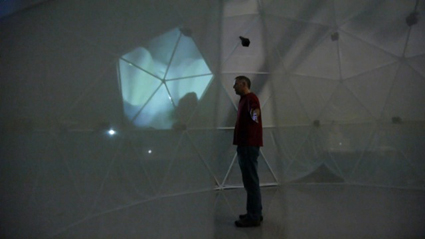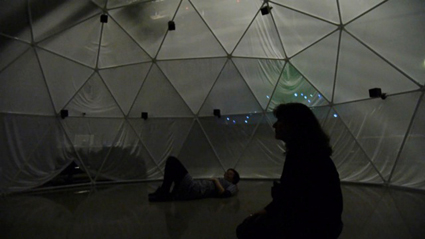July 24 2013
Past-present tensions
Keith Gallasch, Naala-Ba (Look Future), Carriageworks and ISEA2013
July 3 2013
Data noise & the limits of dance
Keith Gallasch, Myriam Gourfink & Kaspar Toeplitz, Breathing Monster
June 26 2013
Nailing the virtual
Virginia Baxter, Keith Gallasch, The Portals
Night work
Keith Gallasch, Embodied Media, Night Rage
Palpable virtualities
Keith Gallasch, Paula Dawson, Holoshop: Drawing and Perceiving in Depth
The big connect
Somaya Langley, The Portals
Transformational walking
Anne Phillips, Long Time, No See?
June 18 2013
Musical multiverses
Gail Priest, Polysonics
Rainbow over ISEA
Keith Gallasch, Electric Nights
realtime tv @ ISEA2013: Zydnei, Troy Innocent
June 17 2013
If a system fails in a forest, is anybody listening?
Urszula Dawkins, If a system fails in a forest…, 107 Projects
June 16 2013
In the digital age, love your stationery obsession
Urszula Dawkins, Durational Book
Painting by algorithms
Keith Gallasch, Ernest Edmonds: Light Logic
June 15 2013
Home, sweet home
Urszula Dawkins, disSentience, Sleeth, SelgasCano, Tin Sheds
Pop up pleasure zones
Gail Priest, Electronic Art Pop-Ups, The Rocks
June 14 2013
Aural ecologies, mechanical and musical
Urszula Dawkins, EchoSonics, UTS Gallery
June 14 2013
Heck, baby, I shoulda seen it comin…
Urszula Dawkins, The Very Near Future, Alex Davies
More than meets the eye
Virginia Baxter, Keith Gallasch, Point of View
New tools and old skool grammars
Gail Priest, Macrophonics II
realtime tv @ ISEA2013: The very near future, Alex Davies
Start by leaping off a small stool
Urszula Dawkins, ISEA Closing Keynote Address: Julian Assange
June 13 2013
A curative dose of spontaneity
Lauren Carroll Harris, pvi collective, Deviator
M e d i a a r t t h e n a n d n o w
Darren Tofts, Catching Light, Campbelltown Arts Centre
Olfaction, decay & speculation
Gail Priest, Raewyn Turner & Brian Harris, Ian Haig, Nandita Kumar, Verge Gallery
ART, WELLNESS & DEATH
Riding the theta waves
Urszula Dawkins, Theta Lab, George Poonkhin Khut and James Brown
Run for your lives [2]
Keith Gallasch, Running the City, COFA, UNSW
To re-map and reclaim
Lisa Gye, Mapping Culture [panel]
Turning the media back on itself
Lisa Gye, Mark Hosler, Adventures in Illegal Art
June 12 2013
Outside the labyrinth…looking in at someone waving
Urszula Dawkins, SoundLabyrinth, Mark Pedersen and Roger Alsop
realtime tv @ ISEA2013: semipermeable (+), SymbioticA
Run for your lives [1]
Keith Gallasch, Marnix de Nijs, Run Motherfucker Run
June 12 2013
The uncanny in the gallery
Keith Gallasch, Mari Velonaki, Simon Ingram, Petra Gemeinboeck & Rob Saunders, Artspace
June 11 2013
realtime tv @ ISEA2013: EchoSonics, UTS Gallery
The science and art of tangible things
Urszula Dawkins, Synapse: A Selection, Powerhouse
Touch me there
Gail Priest, ISEA Artist talks: Siu, Baumann, Velonaki
June 10 2013
Being Stelarc
Gail Priest, Stelarc: Meat, Metal, Code: Engineering affect and aliveness
Life and death, and the membranes inbetween
Urszula Dawkins, semipermeable (+), SymbioticA
realtime tv @ ISEA2013: Catching Light, Campbelltown Arts Centre
June 9 2013
'Pure' experience, in the round
Urszula Dawkins, Pure Land, iCinema
Data lives
Gail Priest, Genevieve Bell, Mark Hosler, Paolo Cirio & Alessandro Ludovico
realtime tv @ ISEA2013: Velonaki, Ingram, Gemeinboeck & Saunders, Artspace
June 8 2013
Knowing your place in Cartesian space
Gail Priest, Ryoji Ikeda, datamatics [ver 2.0]
Stars and starlings, pixels and picknickers
Urszula Dawkins, Ryoji Ikeda, datamatics [ver 2.0] & test pattern
 |
SoundLabyrinth, Mark Pedersen and Roger Alsop
courtesy the artists |
In a utilitarian studio within UTS’s Bon Marche building is a 6-metre geodesic dome, covered in translucent scrim and with 24 speakers ranged around its three-dimensional interior. Through the scrim, the studio’s ceiling lights and exposed piping are visible; behind the dome, two desks are cluttered with laptops and flanked by piles of gear in sturdy roadcases.
Inside, the sound of wind follows me as I move. Then the pings of bell-birds, running water, cathedral bells, all overlapping one another in waves. And a woman’s voice, in French: I catch fragments that translate as “the world and its abundance”, “open me”, “your wisdom and your light”. I feel I’m in a futuristic spiritual incubator, softly proselytised from a spherical dimension. Before I’m completely transported, I notice a set of wavering synthetic sounds, wobbling in microtones toward or away from melody, not always quite succeeding in rising or falling. But today’s experience of SoundLabyrinth is focused on what’s outside the dome: those cluttered desks and what happens behind them.
SoundLabyrinth is created by Melbourne-based artists Mark Pedersen and Roger Alsop. They explain the technical basics to us: essentially, a Mac camera is used to detect light changes, and therefore movement, within the dome’s inner space, which is divided into 16 segments. Gesture drives the installation. Some gestures are unintentional – walking in, for example. But the system recognises movement and responds with sound; the user realises this is happening, which then elicits intentional gestures in response.
 |
SoundLabyrinth, Mark Pedersen and Roger Alsop
courtesy the artists |
Alsop and Pedersen are using separate computer systems to deliver sound to 24 speakers placed throughout the dome; essentially, we’re seeing two independent projects in a shared space. Pedersen’s software system uses ambisonics to place virtual sound objects within the aural space; object ‘placement’ can be driven by his own choices, or he can use the movement of a visitor’s arm, say, as the driver. He achieves this by defining planar location and elevation – imagine a circle with floor position marked, and a semicircle for setting the height. A decoder then does the maths to determine the balance across all 24 speakers. A complex Venn diagram maps out ‘what plays where’ across the floor space, with each overlapping circle representing a sound.
Alsop’s set-up is without the graphical representation of Pedersen’s. Instead his screen is a maze of lozenge-shaped boxes, grids, and connecting lines, representing sensor sectors, range, area, frequencies, amplitude and more. His project uses just eight of the 24 speakers; their outputs are set up either through a compositional sequence, or manually driven. In other words, while Pederson’s ambisonics first maps a spatial sound location and processes accordingly to achieve the result, Alsop’s programming begins with the allocation of sound to individual speakers to ‘create’ the spatial location of the sound as a consequence.
Watching visitors move around the space, waving arms around to see what happens, I wonder what makes us want to ‘interact’ with a work like SoundLabyrinth. Having watched delighted responses to Experimenta’s playful and interactive Speak to Me exhibition at the Powerhouse on the weekend, I’m especially curious. Once upon a time, humans and nature lived in a responsive, reciprocal interaction with nature. In cities, are we hungry for the environment’s response to (or awareness of) us?
Experimenting with all these parameters has an anthropological aspect, says Alsop. For example, in his set-up, some people might stand where they can hear beat frequencies across similar tones, while others avoid them. By setting up minimal differences between speakers – around 8 Hz difference, he suggests –a variety of tonal colours and phases can be achieved as people move in the space. The person almost becomes a synthesiser, he says; their body in effect creating the tones.
Both artists are fascinated by gesture, and by the capacity for computers to read gestures and respond. Alsop says that just about everything we do – even thought – is a gesture: “humans are a gesture recognition system”. Pederson speaks of gesture in the context of encountering the other through immersive spaces – where what you experience can be “both foreign and tactile”.
What gestures mean to people and how much this varies can’t be measured by a computer, Alsop says, but over time it can be ‘taught’ incrementally. A system such as his own for SoundLabyrinth is like a piano – it offers a finite number of choices or notes, but infinite combinations are possible. Human interpretation, on the other hand, is like a cello: multitimbral, infinite.
SoundLabyrinth demonstration and workshop, Mark Pedersen and Roger Alsop, 9–10 June; http://www.isea2013.org/
This article first appeared on RT's ISEA2013-in RealTime blog
© Urszula Dawkins; for permission to reproduce apply to [email protected]
Back to top










 back
back